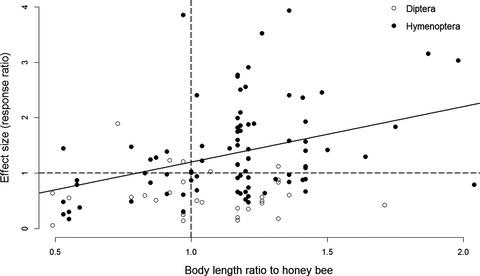当前位置:
X-MOL 学术
›
J. Appl. Ecol.
›
论文详情
Our official English website, www.x-mol.net, welcomes your feedback! (Note: you will need to create a separate account there.)
Larger pollinators deposit more pollen on stigmas across multiple plant species—A meta‐analysis
Journal of Applied Ecology ( IF 5.7 ) Pub Date : 2020-11-24 , DOI: 10.1111/1365-2664.13798 Rita Földesi 1 , Brad G. Howlett 2 , Ingo Grass 3 , Péter Batáry 4
中文翻译:

较大的传粉者在多个植物物种的柱头上沉积更多的花粉-荟萃分析
更新日期:2020-11-24
Journal of Applied Ecology ( IF 5.7 ) Pub Date : 2020-11-24 , DOI: 10.1111/1365-2664.13798 Rita Földesi 1 , Brad G. Howlett 2 , Ingo Grass 3 , Péter Batáry 4
Affiliation

|
- Many insect species provide essential pollination services. However, the amount of pollen deposited onto a stigma when visiting a flower (‘single visit pollen deposition’, SVD) can vary greatly among taxa depending on morphological traits of pollinators. Further, SVD is commonly measured using one of two methods (‘static’: waiting for an insect to visit a flower present on plant, and ‘active’: removing the flower and presenting it to a flower visitor) that may also differ in their effectiveness.
- To gain a more comprehensive understanding of how SVD compares among pollinators, we conducted a hierarchical meta‐analysis using data from 28 studies identified by a systematic review. These contained SVD data for 94 bee and 33 fly taxa (hereafter ‘wild pollinators’), across 30 plant species from which we included 127 observations. In the analysis of each study, we used the western honey bee Apis mellifera as a comparator species.
- Wild pollinators deposited more pollen onto stigmas per single visit than honeybees, and those with larger body deposited significantly more pollen than smaller ones. Of the two methodological approaches to assess SVD, ‘static’ versus ‘active’, we found no significant difference regarding the amount of deposited pollen.
- Synthesis and applications. Our meta‐analysis highlights the breadth of wild pollinators that contribute to pollination effectiveness via their delivery of pollen to many crop and non‐crop plant species. However, just 25% of the observations assessed the amount of pollen deposited by fly species. Our findings point to the need to further quantify the pollination effectiveness of non‐bee pollinators as studies have largely focused on managed and wild bee species.
中文翻译:

较大的传粉者在多个植物物种的柱头上沉积更多的花粉-荟萃分析
- 许多昆虫物种提供了基本的授粉服务。然而,视传粉者的形态特征而定,在访花时在柱头上沉积的花粉量(“单次访问花粉沉积”(SVD))可能会大不相同。此外,SVD通常使用两种方法中的一种进行测量(“静态”:等待昆虫拜访植物上存在的花朵;“主动”:去除花并将其呈现给花客)效力。
- 为了更全面地了解授粉媒介之间SVD的比较,我们使用了系统回顾确定的28项研究的数据进行了分层的荟萃分析。这些数据包含30种植物物种中94种蜜蜂和33种蝇类(以下称“野生传粉者”)的SVD数据,其中包括127个观测值。在每个研究的分析中,我们使用西方蜜蜂Apis mellifera作为比较物种。
- 与蜜蜂相比,野生传粉者每次访问到柱头上的花粉沉积量要多于蜜蜂,而体型较大的传粉者则比较小的花粉散布更多的花粉。在评估SVD的两种方法学方法中,“静态”与“活性”,我们发现沉积的花粉量没有显着差异。
- 综合与应用。我们的荟萃分析突出显示了野生传粉媒介的广度,这些传粉媒介通过将花粉传递给许多农作物和非农作物来提高授粉效率。但是,只有25%的观测值评估了蝇类沉积的花粉量。我们的发现指出,由于研究主要集中在受管理的和野生的蜜蜂物种上,因此需要进一步量化非蜜蜂传粉者的授粉效果。


























 京公网安备 11010802027423号
京公网安备 11010802027423号